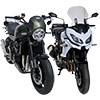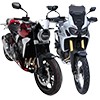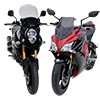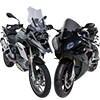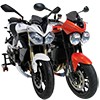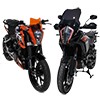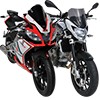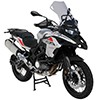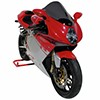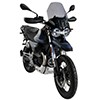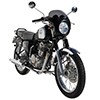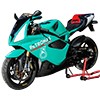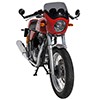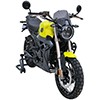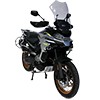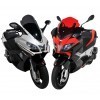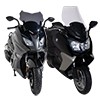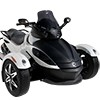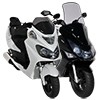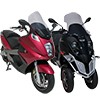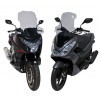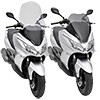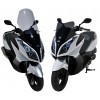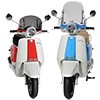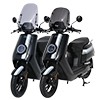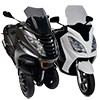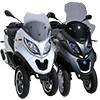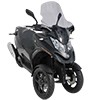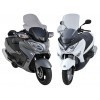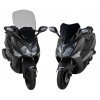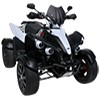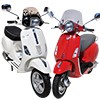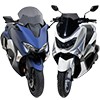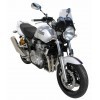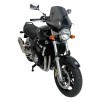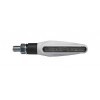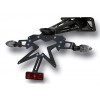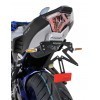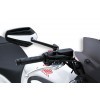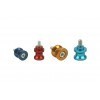
Whether you are a novice in the world of two-wheelers or an experienced motorcyclist, it can happen that you wonder about the equipment: what are the mandatory equipment/accessories? Which ones are recommended? What are the risks involved in not wearing one or more of these devices?
In addition to the motorcyclist's equipment, we will also look at the motorcycle equipment that ensures your safety on board.
THE PROTECTION OF THE BIKER
We will first list and detail all the things you will need to equip yourself with when you ride a motorcycle or scooter:
1) Helmet: In states where a motorcycle helmet is required to ride legally, the law often states the helmet needs to be DOT-approved, meaning it complies with the Department of Transportation's standards. There are both full-face and half-face motorcycle helmets that meet DOT standards, but we recommend purchasing one with greater coverage in case of a serious accident. Non-DOT motorcycle helmets may still protect you, but you would need to check your state's regulations to determine whether you would be driving legally when wearing one. In addition, many states will also require you to wear eye protection while on the road.
There are different types of helmets:
-The full face helmet:  it is the helmet that offers the best protection to the pilot because it protects the entire head and skull. It is strongly recommended, especially if your machine is able to run at high speeds. Although it may offer a certain feeling of confinement, it remains the most effective to date.
it is the helmet that offers the best protection to the pilot because it protects the entire head and skull. It is strongly recommended, especially if your machine is able to run at high speeds. Although it may offer a certain feeling of confinement, it remains the most effective to date.
-The jet helmet:  It is lighter and more comfortable (especially in summer), but it offers only limited protection: it does not cover the face or chin. It is certainly allowed, but not recommended, especially if you have a machine over 50 cm3.
It is lighter and more comfortable (especially in summer), but it offers only limited protection: it does not cover the face or chin. It is certainly allowed, but not recommended, especially if you have a machine over 50 cm3.
-The modular helmet:  it could be described as a "hybrid" helmet, located between the jet and the integral. It does not offer the optimal level of protection of the integral but still has a chin strap. It offers an ideal compromise for peri-urban use.
it could be described as a "hybrid" helmet, located between the jet and the integral. It does not offer the optimal level of protection of the integral but still has a chin strap. It offers an ideal compromise for peri-urban use.
-The bowl helmet:  very rarely used nowadays, it only covers the upper part of the skull. New models can no longer be used on the road because they do not meet modern safety standards. It is this type of helmet that is often seen in films about the Second World War.
very rarely used nowadays, it only covers the upper part of the skull. New models can no longer be used on the road because they do not meet modern safety standards. It is this type of helmet that is often seen in films about the Second World War.
2) The jacket:  Not mandatory but strongly recommended, it is available in several materials: gore-tex, synthetic, leather... some are even equipped with protective covers. In addition to ensuring a certain style, leather provides very good protection against both shocks and cold. Remember that having a good jacket is as important as having a good helmet.
Not mandatory but strongly recommended, it is available in several materials: gore-tex, synthetic, leather... some are even equipped with protective covers. In addition to ensuring a certain style, leather provides very good protection against both shocks and cold. Remember that having a good jacket is as important as having a good helmet.
3) Gloves:  Mandatory since 2016, they must meet CE standards. They should not be too thin or too thick. Concerning the material, leather remains the best it can do (textiles can cause burns). You know that you are holding the ideal pair of gloves when you feel sufficiently protected (warm) but you can still feel the controls.
Mandatory since 2016, they must meet CE standards. They should not be too thin or too thick. Concerning the material, leather remains the best it can do (textiles can cause burns). You know that you are holding the ideal pair of gloves when you feel sufficiently protected (warm) but you can still feel the controls.
4) The yellow vest:  It is not often thought of, but since 2016, the yellow vest must be placed in an easily accessible place so that it can be worn in case of an emergency. If you do not have one, you are also liable to a fine.
It is not often thought of, but since 2016, the yellow vest must be placed in an easily accessible place so that it can be worn in case of an emergency. If you do not have one, you are also liable to a fine.
5) Pants:  like boots, it is recommended but not mandatory. It must be approved if possible and accompanied by appropriate protection. If you don't want to invest in big pants, reinforced jeans can possibly do the trick for urban trips. For long walks, it is better to choose pants with liners, which will protect you from the cold in addition to possible shocks.
like boots, it is recommended but not mandatory. It must be approved if possible and accompanied by appropriate protection. If you don't want to invest in big pants, reinforced jeans can possibly do the trick for urban trips. For long walks, it is better to choose pants with liners, which will protect you from the cold in addition to possible shocks.
6) Shoes / boots:  Optional, but protecting your feet and ankles is still a good idea. In general, boots are recommended for road and track driving, and shoes for city driving, but leather boots are still ideal for any use.
Optional, but protecting your feet and ankles is still a good idea. In general, boots are recommended for road and track driving, and shoes for city driving, but leather boots are still ideal for any use.
7) Miscellaneous protection:  here are nowadays so-called "evolutionary" clothing, i.e. clothing with additional protection such as foam padding, carbon fibre or polymer shells, or even vests equipped with airbags... These clothes certainly represent a certain budget to buy but are worth it, especially if you do not only ride in town and you often go out with your motorcycle or scooter.
here are nowadays so-called "evolutionary" clothing, i.e. clothing with additional protection such as foam padding, carbon fibre or polymer shells, or even vests equipped with airbags... These clothes certainly represent a certain budget to buy but are worth it, especially if you do not only ride in town and you often go out with your motorcycle or scooter.
As a bonus, a small diagram to illustrate the whole thing:

MOTORCYCLE OR SCOOTER EQUIPMENT
When buying your motorcycle or scooter, several criteria are decisive: there is certainly the look, the price, the features and options of all kinds... but an essential factor and too often forgotten is that of safety. And yet, it should be at the top of the list of motorcyclists' concerns.
The first accessory that people often think of when talking about safety on a two-wheeler is ABS: this system prevents the wheels from locking when braking hard. Fortunately, more and more manufacturers are equipping it as standard on their machines, but some motorcycles (especially entry-level ones) lack it, even though its effectiveness is proven and can largely save you the trouble several times. So make sure you choose a machine that is equipped with it as much as possible: the slight extra cost is worth it.
Also make sure that your vehicle is equipped with the necessary equipment such as a left-hand mirror (at least), a solid stand, a speedometer and odometer, an audible warning horn (commonly called a horn, very useful in town), a clear and legible number plate (in accordance with the latest European standards), approved blinkers (available by clicking here), as well as safety devices such as smart keys or geolocalisation tools.
If you follow all these tips carefully, you should be prepared for the dangers of the road!

